#wetland mammals
Text

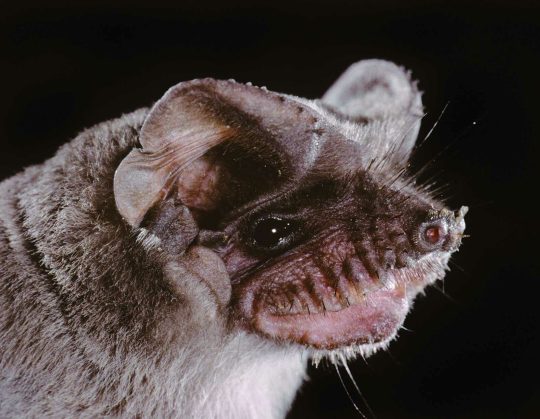

Fly Free with the Mexican Free-tailed Bat
Also known as the Brazilian free-tailed bat, guano bat, or Tadarida brasiliensis, this member of the order Chiroptera is one of the most widely-distributed New World bat species. They are common throughout the southern United States, Central America, and western South America. In many parts of the southern United States, the species is migratory and moves to Central America for the winter. They roost primarily in caves, but can also build nests in buildings; because of this, they can be found in a range of habitats including tropical and deciduous forests, mountains, deserts, and urban areas.
Like most bats, the Mexican free-tailed bat is nocturnal, emerging at sunset to hunt. They are primarily insectivores, and will travel great over 31 km (50 mi) to find food. In fact, this species holds the record for both the highest recorded flight altitude-- at 3.3 km (2 mi) high-- and the fastest flight speed-- an astounding 160 kph (99.4 mph)! That makes the Brazilian free-tailed bat the fastest mammal on Earth, although they can only achieve those top speeds in short bursts and with a good tail wind. Moving that fast can be useful, not only for covering great distances or catching insects, but for avoiding predators like raptors and owls. Young bats that can't fly may also be susceptible to opossums, skunks, and snakes.
The roosts of T. brasiliensis can be quite large; many contain several thousand individuals, while some have been recorded as housing more than a million. For this reason, communication is very important. Mexican free-tailed bats use echolocation to navigate and, for mothers, to locate their young. This species has over 15 distinct calls just for socialization. In addition, they can use their vocalizations to 'jam' the echolocation of other rival species and steal their prey.
Mating for the Brazilian free-tailed bat occurs once a year in the spring. Females gather in large maternity groups, while males mark out a territory by urinating and emitting loud vocalizations. Once a pair mates, the two separate- often to seek out another partner. Gestation lasts 11-12 weeks, and once females give birth they leave their offspring in a group of pups known as a creche, that is cared for communally. The pups take 4-7 weeks to be weaned, and after they learn to fly they join the larger roost as independent adults. However, females take up to 9 months to become sexually mature, while males may take as long as 2 years. In the wild, an individual may live as long as 8 years.
Size-wise, T. brasiliensis is on the smaller side of the bat group. Most individuals are around 9 cm (3.5 in) in length and weigh around 7–12 g (0.25–0.42 oz), with a wingspan of 28 cm (11 in). Females tend to be slightly heavier, but not larger otherwise. The tail of the Mexican free-tailed bat accounts for nearly half its total body length, and is unconnected by the thin membrane that makes up its wings (the uropatagium)-- hence the name 'free-tailed'. The ears are large and rounded, to assist with echolocation, and the muzzle is heavily wrinkled to give them a wider gape when catching bugs in mid-air. The Brazilian free-tailed bat's fur is dark brown or gray, with no distinguishing features save the long, white bristles around their feet.
Conservation status: The IUCN has classified the Mexican free-tailed bat as Near Threatened. However, populations are declining due to habitat destruction and susceptibility to a fungus known as white nose syndrome. Governments in the southern United States and Mexico, as well as private NGOs like Bat Conservation International, have established laws and conservation areas to protect the species.
If you like what I do, consider leaving a tip or buying me a kofi!
Photos
Michael Durham
Merlin D. Tuttle
Carlos Russi
#mexican free-tailed bat#Chiroptera#Molossidae#free-tailed bats#bats#mammals#generalist mammals#tropical forest mammals#deciduous forest mammals#wetland mammals#desert mammals#north america#southern north america#central america#south america#western south america
118 notes
·
View notes
Text

#horses#horse#animals#mustangs#science#education#nature#photography#animal#landsccape#cute animals#funny#lol#adorable#landscape#paradise#explore#gifs#beautiful#beauty#primates#zoos#mammals#wild animals#wildlife#mountain#incredible#running#wetland#river
55 notes
·
View notes
Text
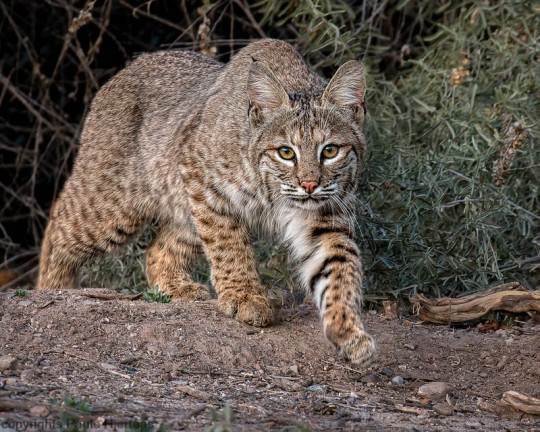
After sunset, the bobcat (Lynx rufus) woke up, walked out followed by rolling on the ground and stretching. Then it walked right up to me, just to the other side of the hedge between us, and peeked through it at me, too close for photos. Sweetwater Wetlands, Tucson, Arizona, USA. 24 January 2019. COTH
By Paule Hjertaas
#paule hjertaas#photographer#sunset#bobcat#lynx rufus#cat#animal#mammal#wildlife#sweetwater wetlands#tucson#arizona#nature
92 notes
·
View notes
Text


#A group of some laid back and happy reptile-folk#I imagine them living around the marshy areas and would have other species including the merfolk#this would prolly include wetland animals altogether since the area would be pretty large and doesnt just stop at the marsh or swamp edges#i mostly just wanted to practice drawing different shapes especially reptiles since their facial structure is so different to mammals#artists on tumblr#character art#digital illustration#sketch#imps rest#artwork#world building#illustration
0 notes
Text
Okay, I know people as a general rule tend to not care about invertebrates as much as cute, fuzzy mammals, but this is a must-read if you care about animal welfare. The short version is that horseshoe crab blood has been used for decades in medicine as a way to test whether something is truly sterile; the blood clots in the presence of bacteria. Since then millions of horseshoe crabs have been captured and drained of blood, even though a synthetic alternative was developed a few years ago.
They go through a pretty brutal experience in the process. They're caught by fishermen who often throw them by their tails into a pile in the open air, and they're then trucked to a bleeding facility where they're strapped down and their blood is removed with needles jabbed directly into their hearts. Over half their blood may be taken, after which they're supposed to be returned to the ocean. However, it's likely many of them never make it back, instead turned into fish bait and sold by the same fishermen who caught them in the first place.
Apart from the fact that this is a horrific thing to put any animal through, the attrition due to fatalities has put a serious dent in horseshoe crab numbers. This is compounded by massive habitat loss, pollution, and the capture of horseshoe crabs as food, particularly as the females of one species are considered a delicacy. And other animals that rely on horseshoe crabs are suffering, too. The American rufa subspecies of the red knot, a medium-sized shorebird, is critically endangered as the horseshoe crab eggs it must have in order to successfully complete migration have become increasingly scarce, and it is likely the bird will become extinct if trends continue.
While there are guidelines for medical horseshoe crab harvest, they're considered optional. The few laws that exist are poorly enforced. Short of a complete ban on horseshoe crab blood in favor of the synthetic alternative, these animals are in very real danger of going extinct after a history spanning over 400 million years on this planet.
Thankfully, this article is not the first to bring forth the issues surrounding horseshoe crab harvest. Here are a few resources for further information and action (US based, though horseshoe crabs are threatened throughout their entire range):
Horseshoe Crab Conservation Network - https://horseshoecrab.org/conservation/
Wetlands Institute - https://wetlandsinstitute.org/conservation/horseshoe-crab-conservation/
Horseshoe Crab Recovery Coalition - https://hscrabrecovery.org/
#animal welfare#animal cruelty#cw animal cruelty#animal suffering#horseshoe crabs#invertebrates#wildlife#animals#environment#conservation#endangered species#extinction#nature#medicine#science#scicomm#science communication
8K notes
·
View notes
Text
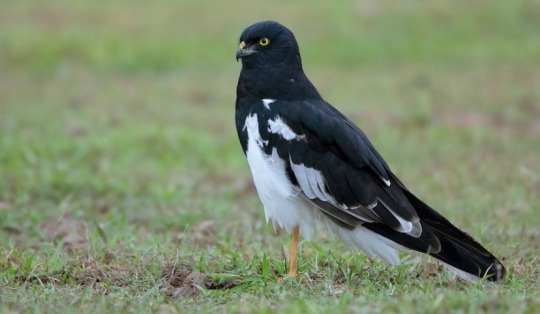


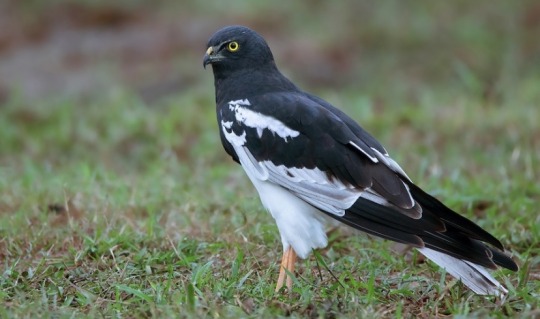
the pied harrier is a medium-sized bird of prey with a wide distribution throughout asia. they are known for their distributive black-and-white coloration. this is a migratory species; during the breeding season, they are found in a wide range from russia to north korea , and during the winter they can be found anywhere between pakistan and the philippines. they feed on small mammals, reptiles, and small birds. the pied harrier also prefers wetland habitat.
3K notes
·
View notes
Note
what are the main prey animals that Shadowclan eat in better bones? because in my rewrite, i can only find like 5 british marshland birds, the frogs like canon, and a common lizard, while the other clans have dozens of prey species. I don't think 7 prey species can feed 50 cats for the generations i need them to, yknow?
This is hard to find out because of the unfortunate reality that wetlands are an "unpopular" natural biome. It's hell out there. No one appreciates their local swamps and marshes </3
But I'M here, NUMBER 1 GOO FAN. Quickie on some of the most common species ShadowClan will be hunting, in an English wetland. 5 for your convenience.
Small intro/recap to BB!ShadowClan's food culture; For a mixture of several reasons, including early collaboration and trade with WindClan, living in an area heavily affected by seasonal changes, and cultural pride in being able to eat anything, ShadowClan has one of the most varied diets of any Clan. Mammals, fish, birds, if they can get their mouth on it, they will eat it.
(Yes. This means predators as well. Other Clans will avoid eating predators for culture and taste reasons. ShadowClan finds it offensive to just let good meat rot.)
The most important reason in that list must be stressed; winter is CRUEL to ShadowClan. The RiverClan river is a moving source of water which rarely completely ices over, most animals in ThunderClan don't hibernate, WindClan's rabbits are active in the snow. For most Clans, they will not feel the "bite" of winter until towards the end, when the prey populations crash. ShadowClan feels it immediately.
That's a problem because Prey Item Number 1 Will Surprise you. The most popular prey in ShadowClan is...
1: Ducks.
And with the most common species, mallards, at about 2 pounds on average (with males being slightly larger) you're looking at 5,442 calories each. Enough to feed 15 warriors for a day.
(Note: This estimate is low; actual value would probably be higher. This measurement is taken from this chart which measured whole carcasses and caloric value rounded from 5.9 to 6, and this particular duck was "dressed"-- so its organs, the most valuable part of the animal, were already removed.)
Ducks are SO valuable as prey it's hard to oversell them. They're huge, they're highly nutritious (thiamin, vitamin a, vitamin b, iron), and they're PACKED with fats. They also lay eggs, TONS of them, which ShadowClan will happily snatch from inattentive hens.
The problem with ducks is, they don't stick around in the winter. Mallards might stay if the weather is mild, but if the water starts freezing, they're a-leaving.
That means that right when ShadowClan needs them the most, they'll vanish. If the marsh freezes, which is VERY likely because it's stillwater, they can't access ANYTHING under the ice. So Prey Animal Number 2 ALSO becomes an issue;
2: Carp
Their size and weight varies immensely, but the european carp is a species that AVERAGES 6 - 15 pounds. Using our rough estimation numbers and only a 6 pound fish, that's 10,884 calories. That's a whole Clan fed, if it's rationed perfectly.
Many carp are larger and heavier than cats. Here is a picture of a human fisher with two 5-pound bass so you can get a feel for just how big fish are
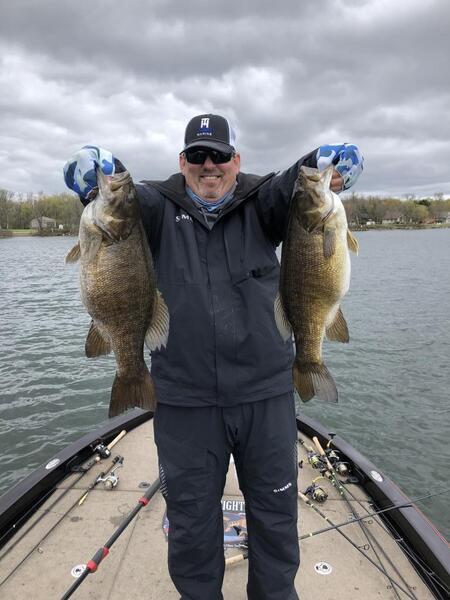
The biggest problem with carp, aside from the fact that icy winter conditions will block access to catching them, is that their gallbladders are poisonous. Carp bile is the only dangerous type of bile Clan cats encounter (that I know about so far). When being eaten, Clan cats must take care to gut them gently and remove the organ without spilling toxic green slime everywhere.
(ShadowClan actually collects and uses this bile for other purposes. Dried and diluted, it can be used as a medicine for treating parasites, and wet and mixed into a poultice it can be used to dress wounds. If gargled, it can also dissolve and loosen stuck bones in the throat, VERY important for unknowing kittens who tried to eat cooked bird bones.)
These two are the most common animals in the highly varied ShadowClan diet. Hunt in the shallow marsh, and you're bound to bump into either a duck or a carp at some point.
But when winter rolls in, they start to rely on mammalian prey.
3: Rats
While some rats can breach 2 pounds (SHOUT OUT TO ALL MY NEW YORKERS) most of them only clock in at about half a pound-- 250 grams. That's 1,250 calories. About 3 cats fed.
(NOTE: These estimations of how MANY cats they feed assumes that these bites are being distributed evenly, such as if the animal was being put into a soup or meticulously portioned. It's more likely that a single rat is eaten alone or only shared between two warriors who then bulk up. The sensation of "fullness" is determined by weight rather than caloric value.)
Rats are highly adaptable omnivores, but most of their diet is actually plants! Humans associate them with garbage and filth, and yes, the rats from carrionplace would certainly taste awful. But most of the rats ShadowClan catches would be living in natural conditions, eating nuts, fruits, and smaller animals. So it doesn't make sense that canon sees ALL rats as dirty-- they should actually be a HUGE part of a warrior's diet!
Especially in ShadowClan, where the invasive brown rat has all but eliminated the native black rat population. Brown rats are huge, thick-tailed, excellent swimmers who stick around in the winter and find themselves right at home in a marsh or swamp.
In fact, ShadowClan thinks hunting them is a two-way blessing. A cat stays fed through the winter, and more resources are freed up for the rarer, but more delicious water vole. ThunderClan isn't the only Clan that understands population management.
And speaking of...
4: Squirrels
Significantly smaller than carp and ducks, gray squirrels are usually about 500 grams. I've heard it said that they triple in mass over the winter, but since I'm not sure if that means they triple in weight, I'll simply rule that a wintertime gray squirrel is 1000 grams. Which means about 5,000 calories, enough to feed 14 cats.
...but also. don't underestimate how big a squirrel is. You are a 200-pound bipedal ape, these are 10 pound cats. They are also eating all the organs you, a human, would usually toss.

The general term, wetland, refers to all land that is... take a guess... wet. The difference between a marsh and a swamp is that a swamp is wooded land, which means squirrels can live there!
ShadowClan often finds itself in conflict with ThunderClan over squirrels. The native, endangered red squirrel is a cultural icon to ThunderClan and they believe it's important to protect it at all costs by killing gray squirrels whenever possible. ShadowClan, meanwhile, agrees red squirrels are beautiful, but isn't willing to be aggressive with gray squirrel populations to protect them.
5: Cheating
In true ShadowClan fashion I do what I want and use number 5 to babble about several animals they turn into grub
And SPEAKING of grubs, they love to forage for larval treats. They regularly make snacks out of chafer grubs, stag beetle larvae, cutworms, and if they can manage it, baby honeybees. Chafer grubs are their absolute favorite, which is another reason why WindClan is so passionate about maintaining their moorland; when it turns into grassland, ShadowClan is energized to fight for grub foraging space.
The "problem" with the meat of predators is that it's said to be tough and taste strong and unpalatable. ShadowClan doesn't entirely mind it, but if they end up with a predator in spring and summer, they like to use the seasonal stream (called a syke) that cuts across ThunderClan to soak the meat in running water for a few days.
Not to mention that they really will just grab at any animal, in addition to those lizards and frogs they're notorious for. Hedgehogs, crayfish, waterbirds, snails. There's all sorts of spices they'll use to try to season a strange meat, between mushrooms, pellitory, juniper, rosemary, so on.
It's harder to find something they WON'T eat.
136 notes
·
View notes
Text
Fossil Novembirb 8: The Raptors Are Back
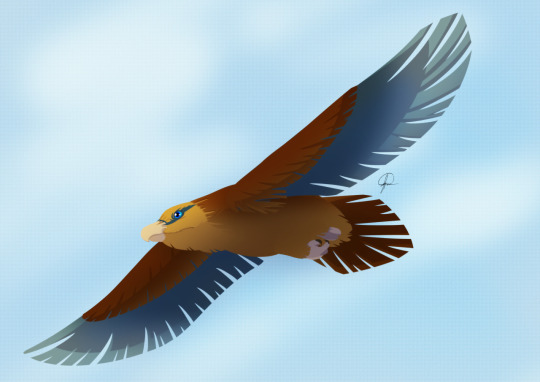
Palaeohierax by @quetzalpali-art!
Alright we're back with a look at the raptors of the Paleogene!
Raptor meaning, of course, bird of prey. Which I wouldn't have to say, except this is a dinosaur blog, and a lot of the time people in dinosaur circles use "raptor" to mean "Dromaeosaur" exclusively. Ironic, given that birds of prey used the word first!

Pulchrapollia by @drawingwithdinosaurs
We've already talked about some of the birds of prey that appeared right after the extinction, such as all the early owls, Qianshanornis, and Danielsraptor. Truth is, being a carnivore is a useful ecology, and birds - having evolved from Paravians like Dromaeosaurs - already have a lot of the tools for chowing down! So, carnivorous birds just keep re-evolving all the time - corvids are sometimes considered raptors, and they're deeply nested within Passerines! And of course, modern roadrunners are essentially mini Velociraptors, but they're cuckoos!
In fact, it seems that most birds alive today evolved from a carnivorous ancestor! All the early-branching members of Telluraves, aka "Core Land Birds" (which includes all passerines and many more besides) are raptorial - owls, hawks, eagles, kites, seriemas, even falcons. And the early ancestors of Passerines and Parrots - things like Halcyornis - were birds of prey as well!
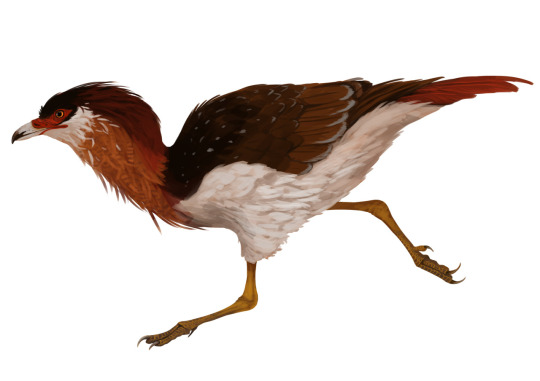
Dynamopterus by @thewoodparable
As we saw with Danielsraptor and Qianshanornis, fast running predatory birds have been a thing since the ash started clearing up from the asteroid. There are just so many small animals to eat and so little time to catch them! Relatives of falcons and seriemas continued to pursue (heh) this lifestyle, and were quite common in the Paleogene fossil record.
In fact, Seriemas - today limited to just a handful of species in South America - had a very successful time of it during the Paleogene and Neogene, with species spread all across the globe. Dynamopterus (sometimes called Idiornis) was from the later Eocene of Europe, and it lived very similarly to living seriemas in its ecosystem! Itaboravis was present in the early Eocene in South America, and we also have Bathornis in North America!
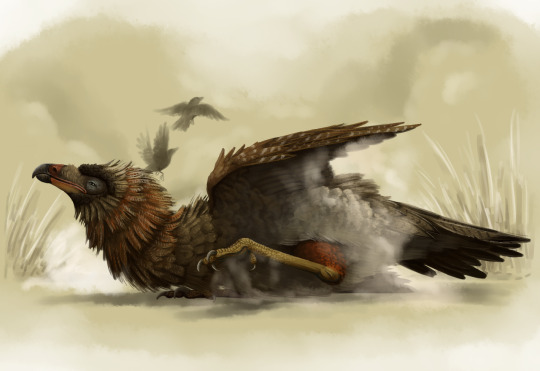
Bathornis by @drawingwithdinosaurs
Bathornis was a very terror-bird-like seriema relative that lived in North America from the Eocene through the Miocene, found in many different environments and at many sizes throughout its existence, including plains and wetlands. Flightless like its terror bird cousins, it had a strong beak to help in catching food and powerful legs for moving quickly across the landscape to catch it!

Ogygoptynx by Apokryltaros/Avancna
Of course, I cannot ignore flighted predatory birds entirely. Though modern ones don't have a lot of fossil relatives (they start appearing in the Oligocene with forms like Palaeohierax), it seems that volant raptors were simply found in other clades - many owls were diurnal, and the relatives of modern parrots and passerines were small carnivores as I mentioned above. With ridges over their eyes to help with glare, these animals could find prey over long distances and fly to them rapidly from their perches - something quite terrifying for the little mammals they ate!
From grasping talons to sickle claws to powerful beaks and eyes, these animals - though small - had major impacts on their environments. Some grew to be so large they would hunt humans - but that's a story for another article.
Sources:
Mayr, 2022. Paleogene Fossil Birds, 2nd Edition. Springer Cham.
Mayr, 2017. Avian Evolution: The Fossil Record of Birds and its Paleobiological Significance (TOPA Topics in Paleobiology). Wiley Blackwell.
88 notes
·
View notes
Text
Animal of the Day!
Yacare Caiman (Caiman yacare)

(Photo from Animalia)
Conservation Status- Least Concern
Habitat- Northern Argentina; Bolivia; Southern Brazil; Paraguay
Size (Weight/Length)- 58 kg; 3 m
Diet- Fish; Crustaceans; Snails; Mollusks; Mammals; Birds
Cool Facts- Nicknamed the piranha caiman, the yacare caiman sports an impressive 74 teeth. These caiman live in slow moving rivers and wetlands with plentiful vegetation along the banks. While yacare caiman prefer cracking open snails, large males are capable of taking down prey as large as capybaras. Most Alligatoridae have a large amount of parental care towards their offspring, yet yacare caiman moms ditch the nest as soon as her babies hatch. In the 1980’s, it was believed these caiman were on track for extinction due to overhunting for their skin. Luckily, in 1992 a ban was placed on trading crocodilian skins and over 10 million individuals survive in the wild today.
Rating- 12/10 (Escargot to go.)
#animal of the day#animals#reptiles#caiman#alligator#saturday#june 17#yacare caiman#biology#science#conservation#the more you know
190 notes
·
View notes
Photo



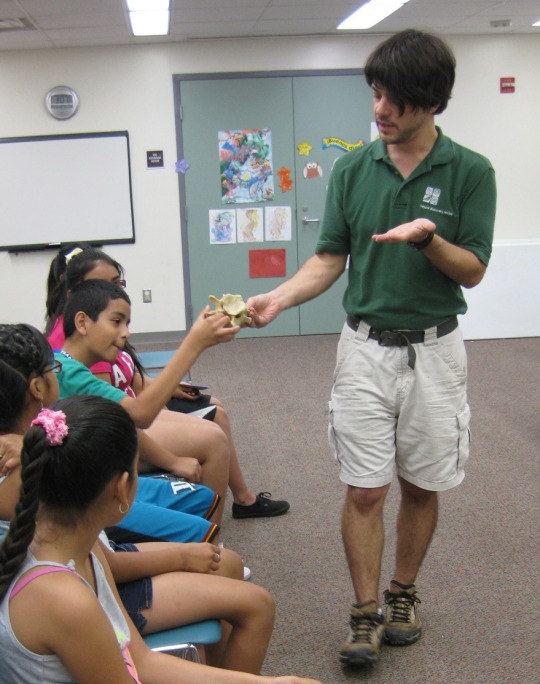

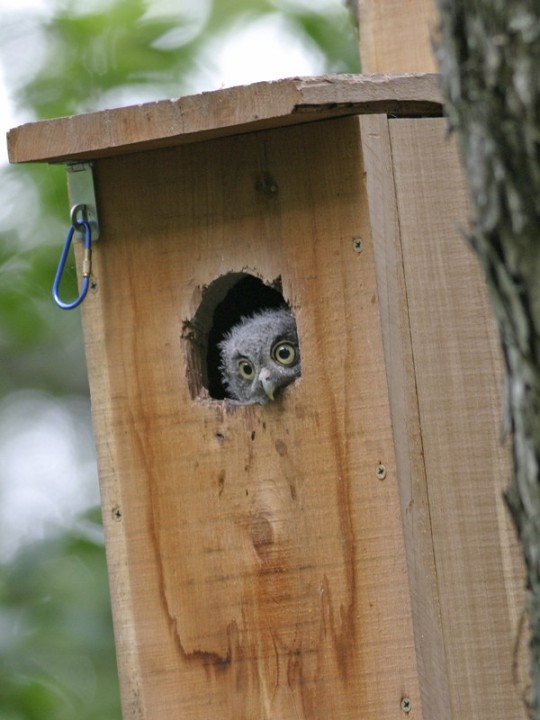
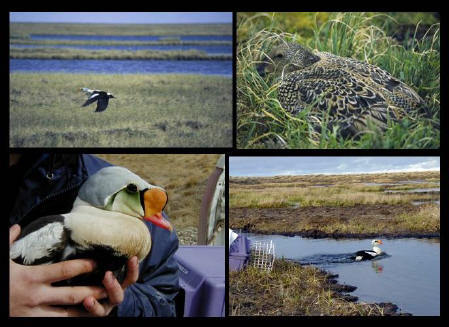



We finally reached 30,000 followers!
Hey y’all, I just wanted to say thank you so much for following the blog. I’ve had a big influx of followers lately, so I thought I’d re-introduce myself.
HI, I’m Paxon. I’m a wildlife biologist, and I work as a naturalist at a nature center in Houston, TX, USA. I’m cis-male, gay, and interested in a variety of leftist political philosophies. Trans-inclusionary intersectional feminist, vegetarian, ANTIFA, anti-racist, Latinx.
This is a science-natural history-wildlife-conservation-biodiversity blog (with some politics, philosophy, Pokémon, anime, poetry, punk, art, cats, gay stuff, naked guys, and other personal interests). :3
____________________________________________________________
I’ve worked in wildlife science and environmental education since I was 17 years old (I’m 45 btw). My field experience includes:
bird surveys,
small mammal surveys,
deer counts,
amphibian call counts,
bayou fish surveys,
reptile and amphibian surveys,
insect surveys,
Loggerhead sea turtle monitoring in Viginia Beach,
Piping Plover monitoring on Long Island, NY,
shark surveys in Florida Bay,
King Eider monitoring on the Arctic tundra of Alaska,
Bluebird and Prothonotary Warbler nest box surveys,
wetland plant monitoring,
prairie and bayou restoration projects.
I’ve worked as a guide and naturalist here in Texas, Corkscrew Swamp in Florida, and at Sacha Lodge in the rainforest of Eastern Ecuador, near Yasuni. #SachaRuna
I AM AN AVID BIRDWATCHER, and spend a lot of time hiking. My nature and outdoor interests include: herpetology, entomology (especially native bees, butterflies, moths, and beetles), malacology, native wildflowers, native wildscape/pollinator gardening, marine biology, and hiking.
I identify animals for people for a living, so if you have any nature questions, or would like me to ID animals for you, I’m here...
https://typhlonectes.tumblr.com/ask
I’m also here if you just wanna chat, say hi, or talk about something else.
Ciao, and thank you for following, I love you,
Paxon
145 notes
·
View notes
Note
Hi!! i was wondering if you could give me some pronouns based off of Maned wolves, and maybe some funfacts
-anonF-
Fun facts:
1. The maned wolf is the largest canid of South America. It looks more like a long-legged fox than a wolf. Genetic studies show that it is neither fox nor true wolf, but a distinct species. It is the only member of its genus, Chrysocyon.
2. The maned wolf stands about 3 feet (90 centimeters) tall at the shoulder and weighs about 50 pounds (23 kilograms).
3. Maned wolves range through central and eastern South America including northern Argentina, South and Central Brazil, Paraguay, Bolivia and southern Peru. They inhabit the cerrado, the largest biome of South America, which is composed of wet and dry forests, grasslands, savannas, marshes and wetlands.
4. Maned wolves mark their territory with powerful-smelling urine and feces on hillocks and termite mounds along their borders. They do not howl, but instead emit loud barks or roar barks to let their mate know where they are, and to warn other wolves to stay away.
5. Maned wolves are omnivorous eaters and primarily solitary hunters. They eat seasonally abundant fruits and vegetables and are particularly interested in lobeira, whose name means "fruit of the wolf." It is a small tomato-like berry that, along with other fruits and vegetables, makes up 50 percent of the maned wolf's diet.
6. They eat small mammals such as rodents, rabbits and insects. Maned wolves rotate their large ears to listen for prey animals in the grass. They tap the ground with a front foot to flush out the prey and pounce to catch it, or they may dig after burrowing prey. They may also leap into the air to capture birds and insects. Long legs help them move through and see above tall grasses.
7. Maned Wolves are crepuscular to nocturnal.
8. Maned wolves exhibit monogamous pairings, with breeding pairs defending a territory averaging 27 km2 (17 mi2.). Despite the concerted defense of territory, male and female wolves typically only associate closely during breeding season.
9. In a zoological setting, male maned wolves have been observed regurgitating food for their young. This may indicate that the male plays a significant role in the care of young in the natural environment.
10. The maned wolf can live up to 12 years in the wild, and as much as 15 years in a controlled setting.
11. The Maned Wolf belongs to the Mammalia class with the scientific name Chyrsocyon brachyurus. Chyrsocyon means golden dog.
12. Male and female Maned wolves have no distinct names. Generally, the male is called a dog, and the female is called a bitch.
13. The Maned wolf babies are referred to as pups, just like their canine counterparts. Scientists have evidence that the adult female produces about two pups at once. These pups reach sexual maturity after at least two years of age.
14. This shy animal is harmless for the most part, flees when alarmed, keeps its distance from people, and rarely attacks only when it feels threatened. From a few documented pieces of evidence, it is concluded that the majority of Maned wolves do not pose any threat to our safety. Other unprovoked attacks by wildlife Maned wolves happened because of Maned wolves' fearlessness due to habituation.
Pronouns:
Mane/Mane’s/Maned/Maneself
Wolf/Wolf’s/Wolves/Wolfself
Fox/Fox’s/Foxes/Foxself
Tall/Tall’s/Tallself
Canine/Canine’s/Canineself
Canid/Canid’s/Canidself
Howl/Howl’s/Howlself
Bark/Bark’s/Barkself
Roar/Roar’s/Roarself
Fur/Fur’s/Furself
Fang/Fang’s/Fangself
Bite/Bite’s/Biteself
Tail/Tail’s/Tailself
Dog/Dog’s/Dogself
Bitch/Bitch’s/Bitches/Bitchself
Pup/Pup’s/Pupself
Puppy/Puppy’s/Puppies/Puppyself
Chyrsocyon/Chyrsocyon’s/Chyrsocyonself
Brachyurus/Brachyurus’s/Brachyuruself
Golden/Golden’s/Goldenself
Paw/Paw’s/Pawself
Fluff/Fluff’s/Fluffself
#alterhuman#alterkin#otherkin#therian#therianthropy#theriotype#canine therian#canine theriotype#caninekin#maned wolf therian#maned wolf kin#maned wolf theriotype#neopronouns#pronouns#fun facts
43 notes
·
View notes
Photo



The Beautiful Boto
Also known as the Amazon river dophin or the pink river dolphin, the boto (Inia geoffrensis) is a species of toothed whale native to the Amazon and Orinoco river basins in South America. Because they reside mainly in rivers, lakes and mangroves, the boto occupies a large range; nearly 7 million square kilometers (435 thousand square miles). Despite being related to whales and dolphins, I. geoffrensis cannot tolerate saltwater and is only found in freshwater.
The Amazon river dolphin is the largest of the four river dolphin species, weighing in at 98-185 kg (215-407 lbs) and measuring 1 to 2.5 m (4-8 ft) in length. Males are larger than females, and are a bright pink to the females’ dull grey. A significant part of the length comes from the dolphin’s distinctive long snout, which is used to hunt for crustaceans and small fish. The boto’s body is designed to be highly flexible, which comes in handy when navigating through flooded forests. One adaptation in particular that makes I. geoffrensis stand out is the unfused neck vertebrae, which allows them to bend at up to a 90-degree angle. Botos also use echolocation to navigate murky river waters. which is enhanced by the large melon on their foreheads.
Breeding for the pink river dophin occurs between May and June, during the rainy season when flooding is at its peak. Males will fight for access to females, and will also perform courtship displays that involve carrying a number of objects-- like branches, fish, or even live turtles-- and slapping them into the water. Successful pregnancies last 11 months, and after giving birth mothers raise their young in the slow-moving waters of flooded forests. Weaning takes about a year, although mother-child pairs will often stay together for much longer. The average lifespan of the boto can be anywhere from 10 to 26 years, as they have no natural predators.
Outside the mating season, I. geoffrensis is a solitary creature. It’s rare to see groups of more than three at a time, and do not heavily defend set territories. However, they are very curious and have been known to readily approach canoes or play with debris in the water. Individuals have also been seen hunting fish in loose cooperation with other species like giant river otters (Pteronura brasiliensis). The bota is crepuscular, active mainly at dawn or dusk, and generally stay close to the surface of the water. Deep dives are rare, as they can only hold their breath for 110 seconds.
Conservation status: Hunting pressure and pollution, as well as dam building and deforestation, are major threats to the amazon river dolphin, which has been classified as Endangered by the IUCN. Conservation efforts are being made, but the species is difficult to keep or breed in captivity so most work is being done in the wild.
If you like what I do, consider leaving a tip or buying me a kofi!
Photos
Sylvain Cordier
Kevin Schafer
#amazon river dolphin#boto#cetacea#Iniidae#river dolphins#dolphins#toothed whales#mammals#rivers#river mammals#wetlands#wetland mammals#tropical rainforests#tropical rainforest mammals#freshwater fauna#freshwater mammals#south america#central south america#Amazon Rainforest#animal facts#biology#zoology
477 notes
·
View notes
Text
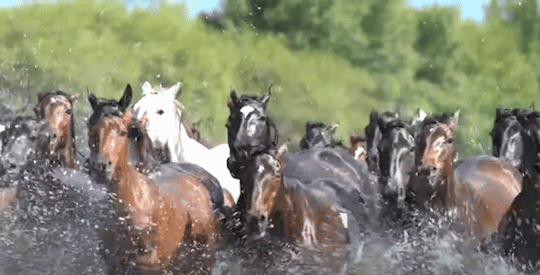
#horses#horse#animals#mustangs#science#education#nature#photography#animal#landsccape#cute animals#funny#lol#adorable#landscape#paradise#explore#gifs#beautiful#beauty#primates#zoos#mammals#wild animals#wildlife#mountain#incredible#running#wetland#river
52 notes
·
View notes
Text
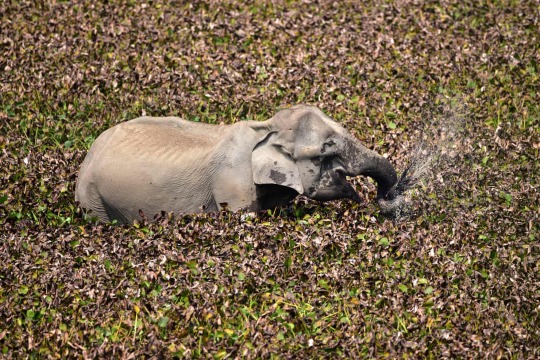
A wild elephant eats water hyacinths in a wetlands in the Burapahar range of Kaziranga national park in Assam, India
Photograph: Anuwar Hazarika/NurPhoto/Rex/Shutterstock
#anuwar hazarika#photographer#nurphoto#rex#shutterstock#elephant#animal#mammal#wildlife#water hyacinths#wetlands#burapahar range#kaziranga national park#assam#india#nature
32 notes
·
View notes
Text
Onondaga Nation Celebrates First Land Return of 1,000 Acres in New York's Tully Valley Following Legal Settlement https://www.goodnewsnetwork.org/onondaga-nation-celebrate-first-substantial-land-return-with-1000-acres-of-new-yorks-tully-valley-won-in-legal-settlement/
In a rare moment of return for East Coast Native Americans, the Onondaga Nation has had 1,023 acres of ancestral land in New York state returned to them.
The land in the Tully Valley includes the headwaters of Onondaga Creek, more than 45 acres of wetland and floodplains, and approximately 980 acres of forests and fields.
The agreement is a result of the March 2018 Natural Resource Damage Assessment and Restoration (NRDAR) settlement between the Natural Resource Trustees and Honeywell International, Inc.
Honeywell, manufactures of household appliances like air conditioners, were found to have been polluting Onondaga Lake in the Tully Valley, Central New York, for almost 100 years, and it had begun to spill into neighboring Onondaga lands.
They have settled on orders to pay $5 million dollars to the Natural Resource Trustees, give the 1,023 acres of land over to the Onondaga, restore several hundred acres of polluted area, and construct 18 projects related to conservation and recreation, of which 7 have been completed.
“It is with great joy that the Onondaga Nation welcomes the return of the first substantial acreage of its ancestral homelands. The Nation can now renew its stewardship obligations to restore these lands and waters and to preserve them for the future generations yet to come,” said Onondaga Nation Chief Tadodaho Sidney Hill.
For the Onondaga people, Onondaga Lake and Onondaga Creek are sacred. They are considered living relatives, central to the Onondaga worldview and spirituality, the tribe detailed in a statement.
Secularly, the cold waters of Onondaga Creek support a small population of brook trout, a population which may be fully restored with proper stewardship. The wetlands, floodplains, forests and fields are home to wildlife such as great blue heron, songbirds, waterfowl, hawks, bald eagles, frogs, bats, and other mammals including white-tailed deer.
“We look forward to drawing upon the Onondaga Nation’s expertise and Indigenous knowledge in helping manage the area’s valuable wildlife and habitat,” said Sect. of the Interior, Deb Haaland.
It’s more common now than ever that tribal nations are recovering rights to use their ancestral lands as they always had, but for tribes in the super-developed Mid-Atlantic region, these opportunities are rare.
However as the Onondaga point out, recent world-wide land surveys have shown that 80% of the world’s biodiversity is currently located in areas stewarded by indigenous peoples, or lands contested as such, despite the fact this amounts to less than half the land of the planet.
As such, they are keen to show what indigenous stewardship can bring to the biodiversity of America’s East Coast, and the current plan with state officials is to turn the Onondaga Lake and Tully Valley into a wildlife sanctuary, but one with ample opportunities for recreation, as Honeywell were ordered to construct many boat launching sites along the lake and rivers.
578 notes
·
View notes
Note
Have you ever considered an environmental (or societal!) worldbuilding post for Taur-im-Duinath? There's so little in canon, I'd be fascinated to know your headcanons.
(This is a somewhat selfish ask as I am writing a fic that will have a significant portion set there, but genuinely love reading your posts -- no rush or pressure on this!)
Environmental World Building Masterlist
Taur Im Duinath is a large forest located in southeast Beleriand. Its name translates to Forest between rivers as it is located between the river Sirion (on the west) and the river Gelion on the east. In its southern reaches on the western border it extends to the lands around the Bay of Balar. The Andram, the wall of rocky hills ending with Amon Ereb in the east, lies directly to the north of Taur Im Duinath
As you said, it is mentioned very little in The Silmarillion, only twice actually. This corner of Beleriand is described as dark, tangled and wild with no elven or human inhabitants save some Avari
It can be difficult to judge exact sizes on Tolkien’s maps but Taur Im Duinath appears to be one of the largest forests in Beleriand
My thoughts
These are more general thoughts and for flora and fauna I gave examples of genuses or families rather than species but if you give me specific categories I can make more detailed posts!
-The climate is not as mild as Ossiriand but is far more mild than northeast Beleriand. The winters do not generally drop below negative one degree Celsius or thirty degrees Fahrenheit. Snow falls lightly in mid winter with sleet often occurring before and after.
-Humidity is higher than the rest of eastern Beleriand excepting parts of central Ossiriand with high rainfall especially in late winter and spring.
-The forest is dense. It is deciduous and coniferous mixed forests with scattered swampier areas which tend to be slightly more open. Most plants must be shade tolerant.
-There is an undergrowth of a variety of species of mosses and ferns as well as fungi. Some species of extremely shade tolerant herbaceous plants grow as well as a wider variety in the wetlands, scattered clearings, and forest edges
-The conifers are primarily spruce, Asian pine, with some fir and even cypress closer to the bay. Tsuga dumosa, a species of hemlock, grows closer to Ossiriand
-The deciduous trees are primarily birch and several species of oak. Ash and tilia species also grow
-Willow and aspen grow in the wetlands and closer to the river with some alders and a few wych elm.
-Animal biodiversity likewise varies throughout the large region. High diversity of small birds, mostly passerine but also nightjars, owls, a few species of ground birds, etc.
-The undergrowth provides habitat for the highest diversity of animals. Lots of Orthoptera (crickets, grasshoppers etc) so the forest is rarely quiet though the dense canopy muffles the sounds. Also high diversity of beetles, worms, rolly pollys, snails and slugs, and then toads, salamanders and newts, certain species of wood frogs, and small mammals like shrews especially by the water
I hope this is ok, @polutrope! I wasn’t sure what areas to focus on so please feel free to ask for more specific areas!
21 notes
·
View notes